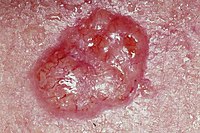
Photo from wikipedia
Recently, the incidence of skin cancer has increased considerably and is seriously threatening human health. Automatic detection of this disease, where early detection is critical to human life, is quite… Click to show full abstract
Recently, the incidence of skin cancer has increased considerably and is seriously threatening human health. Automatic detection of this disease, where early detection is critical to human life, is quite challenging. Factors such as undesirable residues (hair, ruler markers), indistinct boundaries, variable contrast, shape differences, and color differences in the skin lesion images make automatic analysis quite difficult. To overcome these challenges, a highly effective segmentation method based on a fully convolutional network (FCN) is presented in this paper. The proposed improved FCN (iFCN) architecture is used for the segmentation of full-resolution skin lesion images without any pre- or post-processing. It is to support the residual structure of the FCN architecture with spatial information. This situation, which creates a more advanced residual system, enables more precise detection of details on the edges of the lesion, and an analysis independent of skin color can be performed. It offers two contributions: determining the center of the lesion and clarifying the edge details despite the undesirable effects. Two publicly available datasets, the IEEE International Symposium on Biomedical Imaging (ISBI) 2017 Challenge and PH2 datasets, are used to evaluate the performance of the iFCN method. The mean Jaccard index is 78.34%, the mean Dice score is 88.64%, and the mean accuracy value is 95.30% for the proposed method for the ISBI 2017 test dataset. Furthermore, the mean Jaccard index is 87.1%, the mean Dice score is 93.02%, and the mean accuracy value is 96.92% for the proposed method for the PH2 test dataset.
Journal Title: Journal of Digital Imaging
Year Published: 2020
Link to full text (if available)
Share on Social Media: Sign Up to like & get
recommendations!